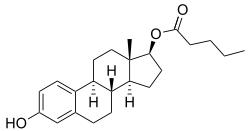Steroid ester
A steroid ester is an ester of a steroid.[1][2] They include androgen esters, estrogen esters, progestogen esters, and corticosteroid esters.[1] Steroid esters may be naturally occurring/endogenous like DHEA sulfate or synthetic like estradiol valerate.[1][2] Esterification is useful because it is often able to render the parent steroid into a prodrug of itself with altered chemical properties such as improved metabolic stability, water solubility, and/or lipophilicity.[2] This, in turn, can enhance pharmacokinetics, for instance by improving the steroid's bioavailability and/or conferring depot activity and hence an extended duration with intramuscular or subcutaneous injection.[1][3]

Sulfur-based esters
Certain sulfur-based steroid esters have a sulfamate or sulfonamide moiety as the ester, typically at the C3 and/or C17β positions. Like many other steroid esters, they are prodrugs. Unlike other steroid esters however, they bypass first-pass metabolism with oral administration and have high oral bioavailability and potency, abolished first-pass hepatic impact, and long elimination half-lives and durations of action. They are under development for potential clinical use. Examples include the estradiol esters estradiol sulfamate (E2MATE; also a potent steroid sulfatase inhibitor) and EC508 (estradiol 17β-(1-(4-(aminosulfonyl)benzoyl)-L-proline)),[4][5] the testosterone ester EC586 (testosterone 17β-(1-((5-(aminosulfonyl)-2-pyridinyl)carbonyl)-L-proline)),[5] and sulfonamide esters of levonorgestrel and etonogestrel.[6]
See also
- List of steroid esters
- Steroid sulfate
References
- Vermeulen A (1975). "Longacting steroid preparations". Acta Clin Belg. 30 (1): 48–55. doi:10.1080/17843286.1975.11716973. PMID 1231448.
- Valentino Stella; Ronald Borchardt; Michael Hageman; Reza Oliyai, Hans Maag, Jefferson Tilley (12 March 2007). Prodrugs: Challenges and Rewards. Springer Science & Business Media. pp. 220–. ISBN 978-0-387-49782-2.CS1 maint: multiple names: authors list (link)
- William N. Taylor, M.D. (16 January 2002). Anabolic Steroids and the Athlete, 2d ed. McFarland. pp. 39–. ISBN 978-0-7864-1128-3.
- Elger W, Wyrwa R, Ahmed G, Meece F, Nair HB, Santhamma B, Killeen Z, Schneider B, Meister R, Schubert H, Nickisch K (January 2017). "Estradiol prodrugs (EP) for efficient oral estrogen treatment and abolished effects on estrogen modulated liver functions". J. Steroid Biochem. Mol. Biol. 165 (Pt B): 305–311. doi:10.1016/j.jsbmb.2016.07.008. PMID 27449818.
- Ahmed G, Elger W, Meece F, Nair HB, Schneider B, Wyrwa R, Nickisch K (October 2017). "A prodrug design for improved oral absorption and reduced hepatic interaction". Bioorg. Med. Chem. 25 (20): 5569–5575. doi:10.1016/j.bmc.2017.08.027. PMID 28886996.
- Meece FA, Ahmed G, Nair H, Santhamma B, Tekmal RR, Zhao C, Pollok NE, Lara J, Shaked Z, Nickisch K (September 2018). "Esters of levonorgestrel and etonogestrel intended as single, subcutaneous-injection, long-lasting contraceptives". Steroids. 137: 47–56. doi:10.1016/j.steroids.2018.07.010. PMC 6137153. PMID 30086356.
Further reading
- Vermeulen A (1975). "Longacting steroid preparations". Acta Clin Belg. 30 (1): 48–55. doi:10.1080/17843286.1975.11716973. PMID 1231448.